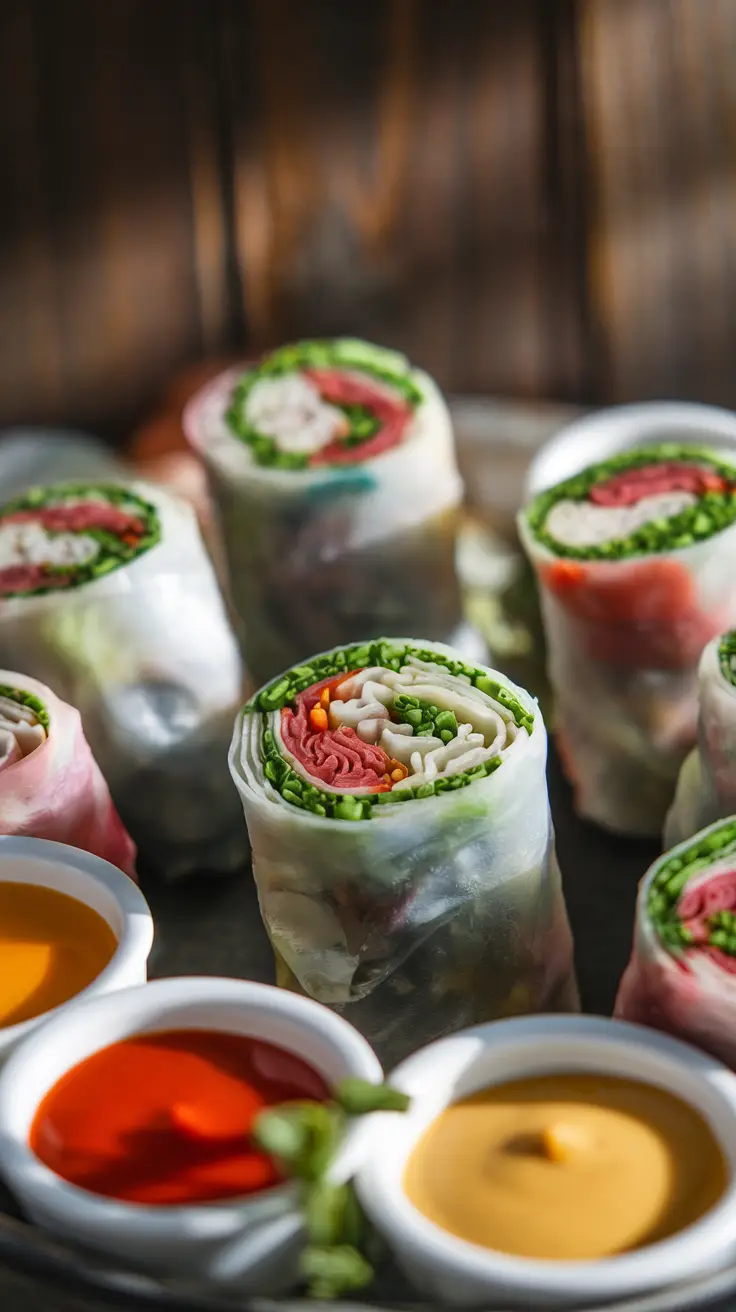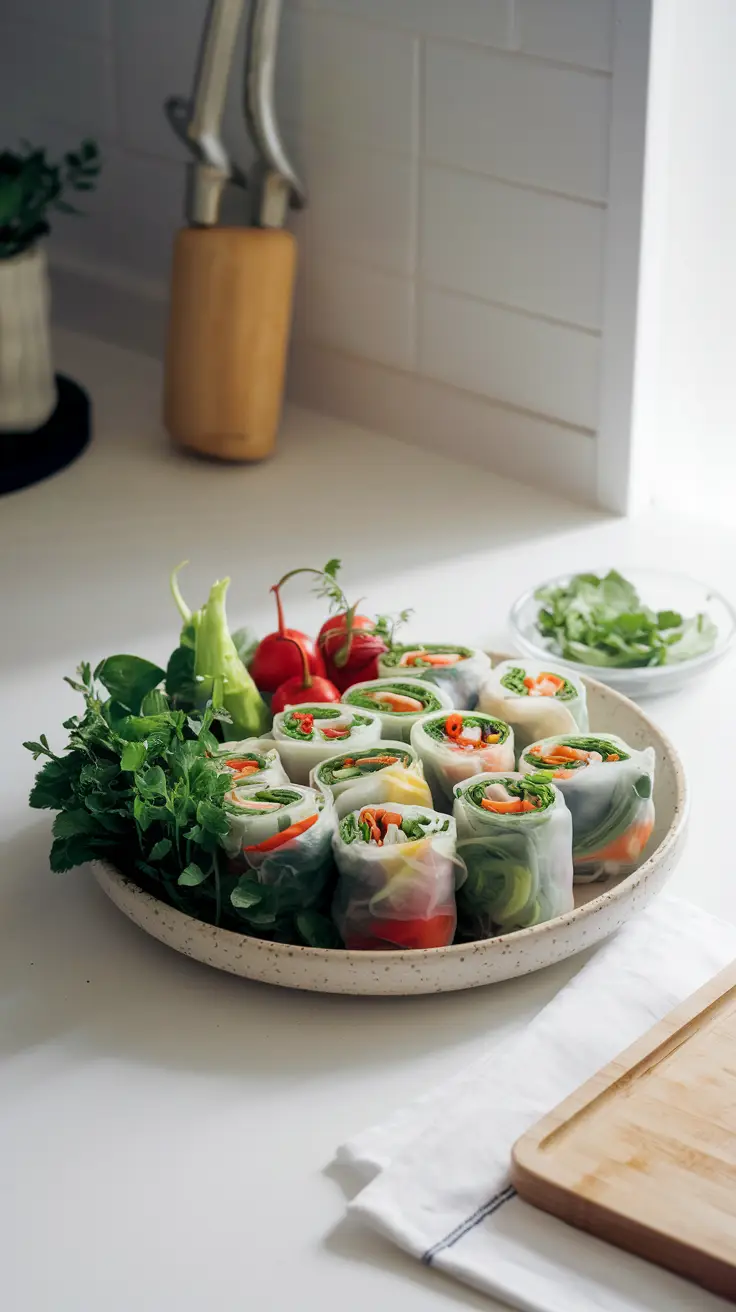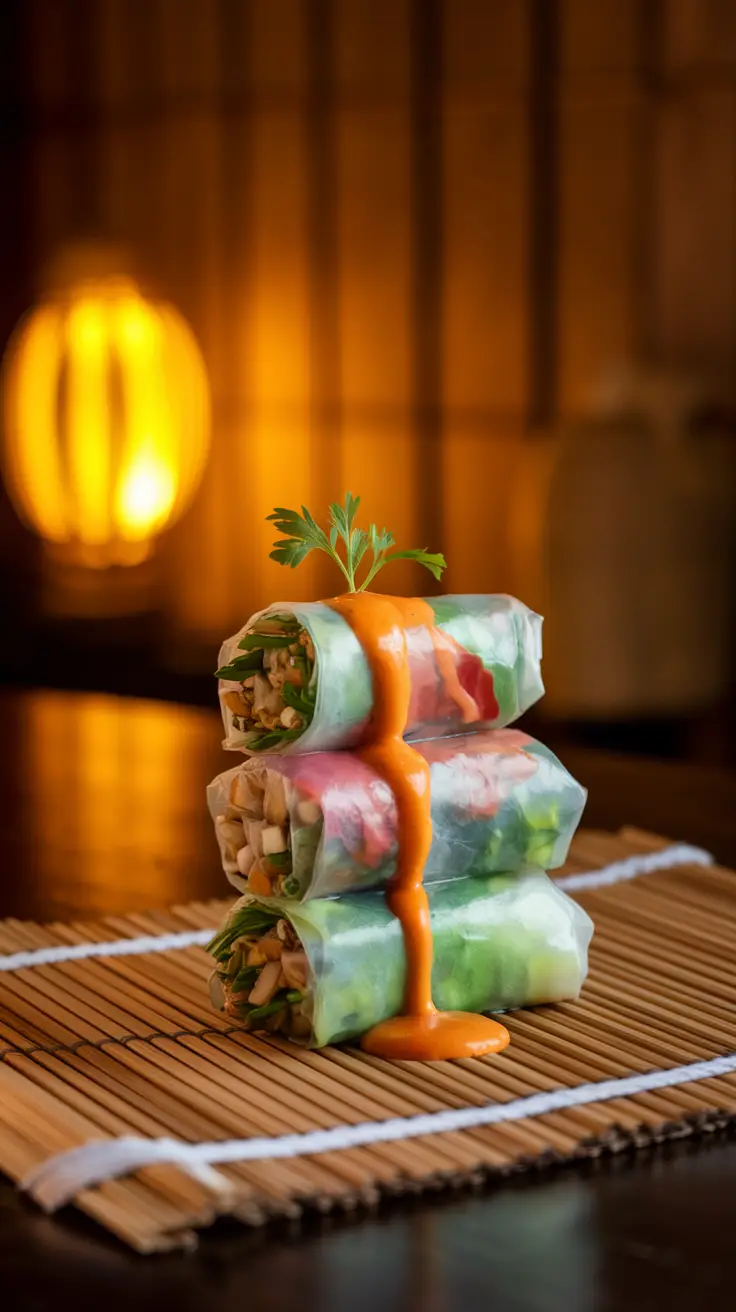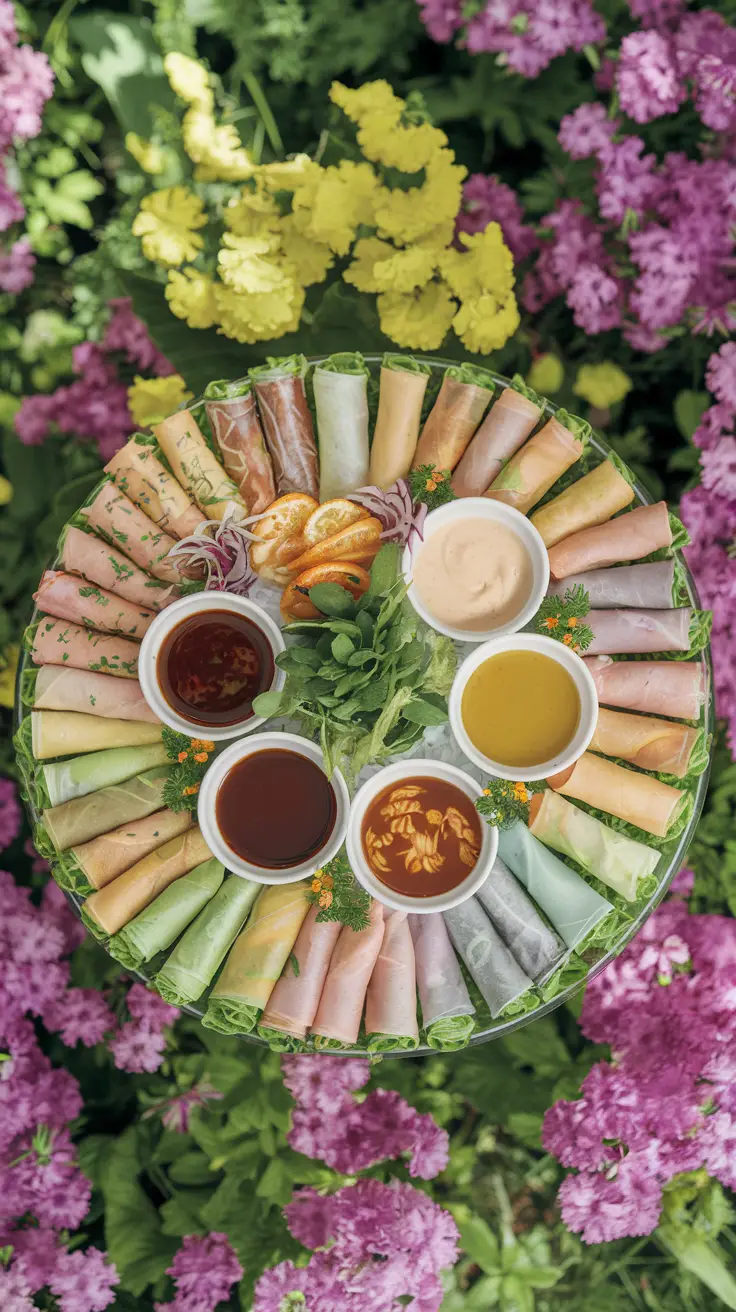Introduction to Spring Rolls
Spring Rolls are delicious appetizers enjoyed in various cuisines. Typically, they feature a thin wrapper filled with vegetables, meat, or seafood. The flavors and textures of spring rolls make them highly appealing. Originating from Asia, they hold a special place in many cultures.
These rolls are versatile and can be served fresh or fried. Additionally, they are often accompanied by dipping sauces, which enhance their flavor. Common ingredients include carrots, cabbage, shrimp, and herbs. People enjoy customizing their rolls based on personal preferences.
In summary, Spring Rolls are not just food; they represent culture and creativity. Their popularity continues to grow, making them a favorite for gatherings and celebrations.

Nutritional Value and Health Benefits
Spring rolls are a popular dish enjoyed worldwide. They are often made with a variety of fresh vegetables, proteins, and light wrappers. These ingredients contribute to their overall nutritional value. Typically, spring rolls are low in calories, making them a great choice for those watching their weight.
A standard serving provides essential nutrients such as fiber, vitamins, and minerals. Moreover, when prepared with lean proteins, such as shrimp or chicken, they offer a good source of protein as well.
Health Benefits
One significant health benefit of spring rolls is their high fiber content, promoting healthy digestion. Additionally, the fresh vegetables used in them are rich in antioxidants. Antioxidants help combat oxidative stress in the body and may reduce the risk of chronic diseases.
Furthermore, spring rolls can be suitable for various dietary preferences, including vegetarian and gluten-free options. They can easily be adapted with different fillings. This flexibility makes them a convenient choice for meals or snacks.
| Nutrient | Per Serving |
|---|---|
| Calories | 100 |
| Protein | 5g |
| Fiber | 2g |
| Fat | 3g |
| Carbohydrates | 15g |

Taste Profile and Texture of Spring Rolls
Spring rolls offer a delightful mix of flavors and textures. The wrapper is usually thin and crisp, providing a satisfying crunch with every bite. Inside, the ingredients contribute to a diverse taste experience. Common fillings include fresh vegetables, herbs, and proteins like shrimp or chicken, which create a harmonious blend.
Key Flavor Components
- Freshness: The use of fresh herbs and vegetables enhances the overall flavor.
- Umami: Ingredients like shrimp or mushrooms add depth to the taste profile.
- Crunch: The crispy outer wrapper contrasts with the soft fillings.
Many spring rolls are served with dipping sauces. These sauces often include hoisin, peanut, or sweet chili. Each sauce further elevates the experience. For instance, a sweet chili sauce balances the savory flavors of the roll.
Texture is just as important as taste. The varying textures from crispy to tender create unique mouthfeel. This complexity makes them appealing to many.
Overall, the taste profile and texture of spring rolls make them a popular choice for appetizers or snacks. Their ability to combine freshness, crunchiness, and umami creates a memorable culinary experience.

Culinary Uses and Popular Dishes Featuring Spring Rolls
Spring rolls are a versatile dish enjoyed in many cuisines. They consist of a thin wrapper filled with vegetables, meat, or seafood. Traditionally, these rolls are deep-fried, but they can also be served fresh. In Asian cuisine, they often include ingredients like shrimp, pork, and glass noodles.
Common Variations and Ingredients
- Vietnamese Spring Rolls: Fresh and filled with herbs, shrimp, and rice vermicelli.
- Chinese Spring Rolls: Typically fried and filled with cabbage, carrots, and sometimes meat.
- Thai Spring Rolls: Can be either fresh or fried, often featuring a mix of vegetables and Thai spices.
They are usually served with a dipping sauce. This might include hoisin, peanut sauce, or nuoc cham. Accordingly, they maintain their popularity in various culinary traditions.

Sourcing and Sustainability
When sourcing ingredients for Spring Rolls, it’s essential to consider sustainability. Many producers focus on eco-friendly practices. Using local vegetables not only supports farmers but also reduces transportation emissions. Moreover, choosing organic ingredients can enhance flavor and minimize pesticide exposure.
Seasonal sourcing ensures freshness and supports local economies. While rice paper is a key component, look for brands that prioritize sustainable sourcing. Additionally, engaging in responsible sourcing practices promotes a healthier planet. By making conscious choices, we can enjoy delicious Spring Rolls while caring for our environment.
How to Select and Store
Selecting the right ingredients for Spring Rolls is crucial for flavor and texture. Look for fresh vegetables that are crisp and vibrant. Choose proteins like shrimp, chicken, or tofu based on your preference. Additionally, ensure that the wrappers are well-packaged and free from tears.
Once you’ve selected your ingredients, proper storage is essential. Follow these guidelines for optimal freshness:
- Store vegetables: Keep them in a cool, dry place. For longer freshness, refrigerate them in a sealed container.
- Wraps: Store rice paper wraps in a cool, dry area away from moisture. Keeping them sealed prevents damage.
- Prepared rolls: If you’ve made them, consume them within a few hours. However, if you need to store them, wrap them in plastic and refrigerate. Eat within 24 hours for best quality.
Proper selection and storage will enhance your dish experience, ensuring fresh and flavorful bites each time.
Preparation Tips and Techniques for Spring Rolls
Making delicious Spring Rolls requires attention to detail and some practice. First, gather your ingredients. You’ll need fresh vegetables, proteins, and rice paper wrappers. Choose seasonal produce for the best flavor. Next, prepare your fillings. Chop vegetables uniformly for even cooking and easy wrapping.
Here are some essential tips:
- Soften rice paper in warm water briefly, but avoid over-soaking.
- Layer filling ingredients neatly to make rolling easier.
- Wrap tightly, but don’t squeeze too hard to prevent tearing.
- Use a damp cloth to keep rice papers moist while working.
- Experiment with dipping sauces like sweet chili or peanut sauce.
To achieve the perfect texture, consider frying your rolls for a crispy finish. Always preheat oil to ensure an even cook. Finally, remember to serve your them immediately for the best taste. With these tips, you’ll impress friends and family with your rolls.
Recipe Inspiration
Spring rolls are a delightful dish enjoyed all over the world. They are often filled with fresh vegetables, herbs, and sometimes protein. One popular option is to use shrimp or chicken, adding a savory element to the roll. Furthermore, these rolls can be served with a variety of dipping sauces, including sweet chili or peanut sauce, enhancing their flavor even more.
Additionally, vibrant colors make spring rolls visually appealing. This appeal encourages more people to try making them at home. You can experiment with different fillings, such as tofu, rice noodles, or a mix of colorful vegetables. For instance, carrots, bell peppers, and lettuce can brighten up the dish.
Moreover, wrapping techniques can vary. Some prefer the traditional rice paper, while others might use lettuce wraps for a low-carb option. Overall, they offer numerous possibilities for creativity in the kitchen. They can be a healthy appetizer or a light meal, perfect for any occasion.
Fun Facts and Trivia
Spring Rolls are a beloved dish around the world. They are often associated with celebrations and gatherings. Interestingly, these rolls are not just snacks; they have deep cultural significance in many cuisines.
- Spring Rolls are commonly enjoyed during Lunar New Year festivities.
- The filling varies by region, including vegetables, meats, and seafood.
- Some people believe that the shape symbolizes wealth and prosperity.
- Different countries have unique versions.
- They are often served with a variety of dipping sauces.
These fun facts highlight the enduring popularity of them. Each bite carries a rich tradition that continues to delight people everywhere.
Spring Rolls: Conclusion and Dining Experience
In conclusion, the experience of enjoying Spring Rolls encompasses delightful flavors and remarkable textures. These dishes offer a perfect balance of crunch and freshness. When prepared authentically, Their serve as an excellent appetizer or snack. Moreover, the variety in fillings, such as vegetables, shrimp, or chicken, makes them versatile for different tastes.
Elegant presentation adds to their appeal, making them popular in many dining settings. Whether enjoyed during festive occasions or casual meals, Spring Rolls remain a favorite for many. As you explore various recipes, consider pairing them with a zesty dipping sauce. This enhances the overall flavor profile and dining experience.
